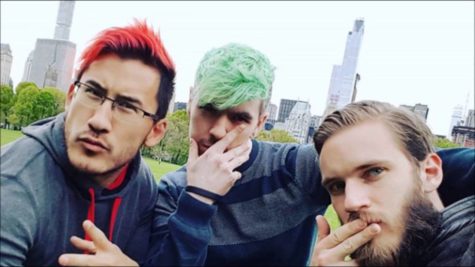YouTube is hurting their content creators
January 9, 2018
 According to Alexa.com, YouTube is the second most heavily trafficked website in the world, beaten only by its parent company, Google. Creators known as ‘YouTubers’ on the site create content of varied forms for multi-millions of fans; however since September of 2016, YouTube in a new way to regulate the growing site has hurt their content creators and shattered the mask of a entertainment platform to a cold, greedy corporation through demonetization.
According to Alexa.com, YouTube is the second most heavily trafficked website in the world, beaten only by its parent company, Google. Creators known as ‘YouTubers’ on the site create content of varied forms for multi-millions of fans; however since September of 2016, YouTube in a new way to regulate the growing site has hurt their content creators and shattered the mask of a entertainment platform to a cold, greedy corporation through demonetization.
What is it?
demonetization on YouTube strips away a content creators ability to profit off of their creations. The purpose of system is to crackdown on content it claims is not-suitable for advertisers on the site. The result of this policy, dubbed “demonetization”, has created deep divides in the YouTube community and continues to cripple the platform without a successful, honest way to assist affected YouTubers.

Regulation Hypocrisy
Since the end of 2016, the controversy with YouTube’s algorithm has taken a shift from annoyance and distress to an uproar from it’s content creators and their fans. This uproar was unleashed after the Las Vegas attack where YouTuber Casey Neistat uploaded a video called “Let’s Help the Victims of the Las Vegas Attack.” In this video, he never showcases the tragedy, but simply advocates to raise money for victims and provides a link to a ‘GoFundMe’ and promises that all profit will be donated as well.
Unfortunately, Neistat’s video is demonetized and after he made a request to appeal the demonetization, he was messaged 21 hours later by a member of the YouTube team stating, “We love what you’re doing to help, but no matter the intent, our policy is to not run ads on the videos about tragedies.” YouTube may be correct that videos about recent tragedies, even if presented for news or documentary purposes, may not be suitable for advertising given the subject matter. Then came complete hypocrisy on YouTube’s end, where a video released by Jimmy Kimmel Live called “Jimmy Kimmel on Mass Shooting in Las Vegas ” and this video was monetized by YouTube. This video under YouTube’s guidelines should have been reviewed, one cannot claim it was out YouTube’s sight as it was Number 1 on YouTube’s trending page.
This move was never addressed by YouTube and has a result struck a deep divide in content creators and the platform they live on. YouTuber Philip DeFranco, who defends Neistat, explains this divide best when he says “Even still, this seems like a big middle-finger to an average creator. There are different rules based on your size…not audience size, company size.”
“Advertiser Friendly”
The policy that YouTube is enforcing is known as the “Advertiser-Friendly Content Guidelines.” With this document, YouTube lists content and practices that are not suitable for their advertisers. What this means is that by following the guidelines, honest users of the site should be protected and, in theory, the website more safe for viewers. In practice, this policy is poorly run by the site’s algorithm which changes constantly. To YouTube’s credit, according to fortunelords.com, over 300 hours of video are uploaded every minute, which is too much to be monitored effectively, and thus is the reason for the site’s algorithm to find videos that violate its guidelines. However their method of handling reviews of demonetization claims are deeply flawed and needs attention.
The demonization policy claims a video can be a reviewed once demonetized, the YouTube team is meant to review the video and deem it either worthy or unworthy of monetization. The flaw is that when it is demonetized the video can still be viewed and watched without ads. The content creator cannot profit from this whatsoever until the video is reviewed, which leads creates a loss of the bulk of the views it will receive. YouTube is not reimbursing their YouTubers from this loss of profit.
Strangely enough, YouTube seems to be blind to that loss of profit their content creators are experiencing, which hurts them as well. When a video receives millions of views and has no advertisements at its forefront, this means that the video alone has the potential for millions of consumers to see the what was being advertised and the money made off of this viewership all but nonexistent. Any action taken is riddled with risks that the company may experience, but in the end it seems that with every move YouTube has made so far it’s content creators are always receiving the blunt end of it.
Lack of Communication
On November 2nd of 2017, content creator Gus Johnson uploaded a video called “YouTube Is Deleting My Videos Without Warning” in the video Johnson gives a rundown of his situation where his videos began to simply disappear “I have received no notification for any of these things, no copyright strikes, no claims…they’re just plain gone.” Johnson then updated later in the month on November 17th where he gives support to claims made by other YouTubers, this action seeming to be an attempt to validate others claims.
 What is most troubling about this controversy is the misunderstanding of the severity it brings. For YouTuber Gus Johnson this cannot be more clear, while he has not amassed great fame and fortune on the site he earns a decent living with near 200,000 subscribers and posting once or twice a week. Johnson admits the privilege he holds in making videos for a living, YouTube is his single income, as many others “It’s people like me, creators that are about this size for where every single paycheck counts, depending on if you can fill up the car for the month, pay the rent, buy the groceries…people like myself, Eddy Burback and Dolan Dark-those guys-who get hit with demonetization and it really as the potential to [screw] up their earnings for the month.”
What is most troubling about this controversy is the misunderstanding of the severity it brings. For YouTuber Gus Johnson this cannot be more clear, while he has not amassed great fame and fortune on the site he earns a decent living with near 200,000 subscribers and posting once or twice a week. Johnson admits the privilege he holds in making videos for a living, YouTube is his single income, as many others “It’s people like me, creators that are about this size for where every single paycheck counts, depending on if you can fill up the car for the month, pay the rent, buy the groceries…people like myself, Eddy Burback and Dolan Dark-those guys-who get hit with demonetization and it really as the potential to [screw] up their earnings for the month.”
Punishing Smaller Creators
What’s happening to these smaller creators is something that should be addressed by YouTube with sincerity as YouTube gives no response to these situations or give help; what seems to happen is puni
 shment. YouTube implemented a even more recent policy, this time to damaging smaller YouTubers on the platform by blocking creators from using links to Patreon, a site much similar to GoFundMe; however subscriptions can be for purchase.
shment. YouTube implemented a even more recent policy, this time to damaging smaller YouTubers on the platform by blocking creators from using links to Patreon, a site much similar to GoFundMe; however subscriptions can be for purchase.
In an article by polygon.com YouTube began to block these external links and ask creators to join the YouTube Partners Program which allows monetization on a video and in theory brings in profits for a creator’s content. This policy comes with a-catch however; this mandates that a channel must reach 10,000 views before they can apply. For many creators this feat is easier said than done as the rise to stardom on YouTube is more difficult than ever before to achieve. YouTuber Brandon Rodgers, who now holds 3.5 million subscribers, has been posting videos consistently with a high production quality since 2006, yet only in the last year has skyrocketed into fame.
Rodgers was held on for a decade due to the previous guidelines of YouTube where one didn’t have to meet the 10,000 subscriber mark before they could profit off their work. Thanks to a devoted audience and luck, he was able to rise and now relies on YouTube has his main source of income much like many others, yet the content creators that are the size which Rodgers once was can’t compete with the unfair algorithm and a what seems to be a digital glass ceiling.
Just a Corporation
Ever since 2011 holds a YouTube community tradition at the end of the year, Y
 ouTubers are gathered to collaborate in a massive music video highlighting significant YouTube moments through the year. The most popular being 2016 which boasted 202 Million views, and also the most hated. 2016 was a year of change for, most profound being what YouTube considers a priority, look no further than “YouTube Rewind: The Ultimate 2016 Challenge | #YouTubeRewind” this video received historic dislikes for a YouTube Rewind, where it held 3 million likes, it also had 492k dislikes and it’s not hard to understand why.
ouTubers are gathered to collaborate in a massive music video highlighting significant YouTube moments through the year. The most popular being 2016 which boasted 202 Million views, and also the most hated. 2016 was a year of change for, most profound being what YouTube considers a priority, look no further than “YouTube Rewind: The Ultimate 2016 Challenge | #YouTubeRewind” this video received historic dislikes for a YouTube Rewind, where it held 3 million likes, it also had 492k dislikes and it’s not hard to understand why.
In YouTube Rewind, the video normally begins with PewDiePie, the largest YouTuber on the site, however it opens to Dwayne “The Rock” Johnson holding the YouTube ‘playbutton’, one might say this is logical because The Rock started a YouTube channel. Then why was the cast of The Daily Show there? Or Daniel Lara from Vine? Seth Meyers? James Corden? The YouTuber that were shown for the majority of the video were beauty channels, vloggers, dancing channels and talk show hosts.
This is not a reflection of YouTube’s community. Beauty channels are huge as well as vloggers, yet the massive portion of YouTube’s platform are gaming channels such as VanossGaming, Markiplier, Jacksepticeye, and PewDiePie who received a significantly part. There is a demand for change from its creators and its viewers; whether or not YouTube decides to answer this will be determined by time.
Change Needs to Happen Now
YouTube can not ignore the controversies it faces. No creator is safe from the crippling policies YouTube is implementing into its system, and viewers more than ever need to show their support in any form. This can be as simple as leaving a comment and liking the video as that plays favorably into YouTube’s algorithm.
Above all, YouTube needs to hold itself accountable for the damage it’s doing to creators big and small across the platform, and understand where it holds the most value — in the corporation or the nobodys that made it successful.